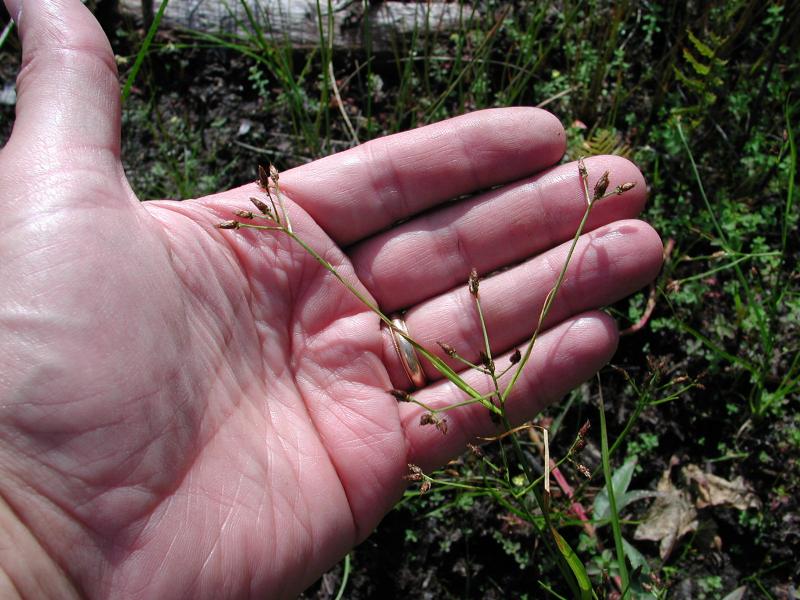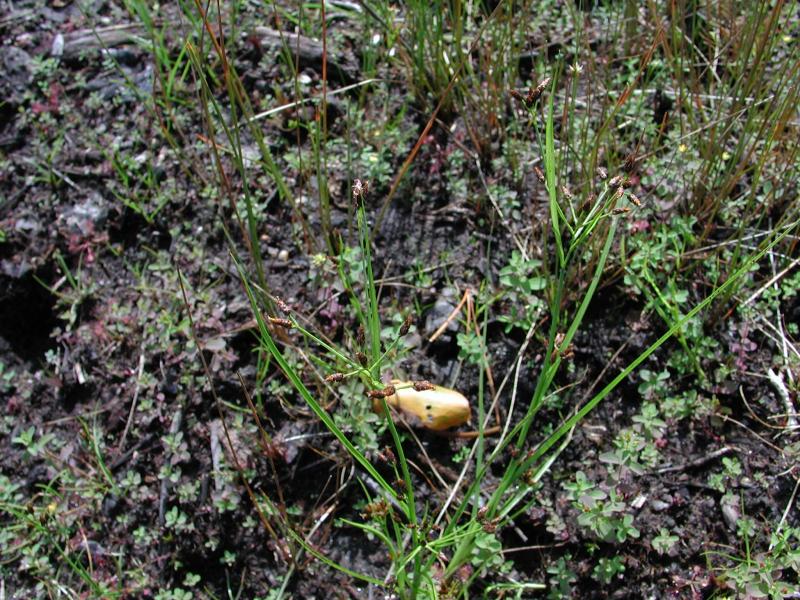Long-beaked Beak Sedge
Rhynchospora scirpoides (Torr.) Gray
- Class
- Monocotyledoneae (Monocots)
- Family
- Cyperaceae (Sedge Family)
- State Protection
- Rare
A plant listed as Rare by New York State. Removal or damage without the consent of the landowner is prohibited.
- Federal Protection
- Not Listed
- State Conservation Status Rank
- S2
Imperiled in New York - Very vulnerable to disappearing from New York due to rarity or other factors; typically 6 to 20 populations or locations in New York, very few individuals, very restricted range, few remaining acres (or miles of stream), and/or steep declines.
- Global Conservation Status Rank
- G4
Apparently Secure globally - Uncommon in the world but not rare; usually widespread, but may be rare in some parts of its range; possibly some cause for long-term concern due to declines or other factors.
Summary
Did you know?
Even though the common name is long-beaked beakrush this species is truly a sedge and not a rush. The specific epithet "scirpoides" means Scirpus like. Scirpus is another genus in the sedge family (Fernald 1970).
State Ranking Justification
There are 33 known extant populations. There are 3 populations which have not been seen in over 65 years. One population has been extirpated. 24 of the known extant populations are of excellent to good quality (ranked A or B). Most of the populations are small in terms of acreage. The habitat that is required for this species is very specific and extremely limited in New York. Most of the populations are clustered together and all but one are known from eastern Suffolk County, Long Island.
Short-term Trends
Many of the known extant populations were first documented within the past 25 years. It is likely these populations were simply overlooked in the past. It is difficult to determine trends with this species as its populations fluctuate in size depending on pond water levels during a particular year. No populations are known to have become extirpated in recent years. Overall, short term trends are not clear but may indicate that this species is stable.
Long-term Trends
There are 33 known extant populations. Many of these populations were first documented within the past 25 years. It is likely these populations were simply overlooked in the past. There are 3 populations which have not been seen in over 65 years. One population has been extirpated. Overall, long term trends indicate a small decline.
Conservation and Management
Threats
This species is threatened by disturbances caused by residential development especially along pond shores. It is also threatened by off road vehicles disturbing the habitat where it occurs.
Conservation Strategies and Management Practices
The ponds should be protected from use by off road vehicles and from development. The hydrology of sites where the species occurs needs to be maintained.
Research Needs
The three historical populations should be surveyed to determine if these populations are still extant. The extant populations should be monitored on a regular basis.
Habitat
Habitat
In New York, this species occurs predominately on mucky or sandy soils on the margins and drawdown zones at the edges of coastal plain ponds in pine barrens of eastern Suffolk County, Long Island. When water levels stay high in these ponds, the available habitat and therefore the number of plants, are limited. It also occurs in bog-like or inland poor fen habitat with rich, peaty, acidic, and mucky soils (New York Natural Heritage Program 2002). Limesink ponds, usually at the lower margins of pond-shores, wet savannas, beaver ponds, and other wetlands with "drawdown" hydrology (Weakley 2007). Moist to wet sands or peats of banks of streams and ditches, ponds and lakeshores, depressions in savannas, marshes, often in moist to wet disturbed areas (Kral 2002). Wet sandy soil (Gleason and Cronquist 1991). In Michigan, occurs on sandy-mucky shores, sandy-peaty lake beds, and in a marly bog (Voss 1972). Peaty and sandy shores and swamps (Fernald 1970).
Associated Ecological Communities
- Coastal plain pond shore
(guide)
The gently sloping shore of a coastal plain pond with seasonally and annually fluctuating water levels. Plants growing on the pond shore vary with water levels. In dry years when water levels are low there is often a dense growth of annual sedges, grasses, and herbs. Submerged and floating-leaved aquatic plants, such as fragrant waterlily and pondweeds, may become "stranded" on the exposed shore. In wet years when the water level is high only a few emergents and floating-leaved aquatics may be noticeable. T
- Inland poor fen
(guide)
A wetland fed by acidic water from springs and seeps. Plant remains in these fens do not decompose rapidly and thus the plants in these fens usually grow on older, undecomposed plant parts of mostly sphagnum mosses.
Associated Species
- Cyperus dentatus (toothed flat sedge)
- Drosera intermedia (spatulate-leaved sundew)
- Eleocharis flavescens var. olivacea (Torr.) Gleason
- Eleocharis melanocarpa (black-fruited spike-rush)
- Eleocharis obtusa
- Eleocharis robbinsii (Robbins's spike-rush)
- Eriocaulon aquaticum (northern pipewort, northern hat-pins)
- Fimbristylis autumnalis (autumn fimbry)
- Gratiola aurea (golden hedge-hyssop)
- Hypericum canadense (lesser Canadian St. John's-wort)
- Juncus militaris (bayonet rush)
- Juncus pelocarpus (brown-fruited rush)
- Nymphaea odorata
- Panicum verrucosum
- Rhexia virginica (Virginia meadow-beauty)
- Rhynchospora alba (white beak sedge)
- Rhynchospora capitellata (brownish beak sedge)
- Rhynchospora macrostachya (tall horned beak sedge)
- Rhynchospora nitens (short-beaked beak sedge)
- Schoenoplectus purshianus
- Scleria reticularis (netted nut sedge)
Range
New York State Distribution
Rhynchospora scirpoides is almost exclusively limited to the Long Island pine barrens region, from the South Fork to north-central Suffolk County. There is also one disjunct population known from the Cranberry Lakes Preserve in Westchester County (New York Natural Heritage Program 2007).
Global Distribution
This species occurs from southeastern Massachusetts south along the coast to the panhandle of Florida and west along the Gulf Coast to Texas. It is also disjunct around the Great Lakes in Michigan, Wisconsin, and Indiana, and occurs in the West Indies (Kral 2002, Weakley 2007).
Identification Comments
General Description
Long-beaked beakrush is a grass-like annual herbaceous plant that grows in clumps and is generally 30 to 80 centimeters tall. The leaves are narrow and strap-like. The stems are stiff and leafy. Clusters of minute inconspicuous flowers occur on secondary branches which arise from axils and summits of the stems. The flowers develop into small inconspicuous fruits (Kral 2002).
Best Life Stage for Proper Identification
The easiest time to identify this species is when it has mature fruits.
Similar Species
Rhynchospora nitens is a closely related species. It differs in having a short broad tubercle (0.1-0.3 mm tall) and achenes strongly ridged vs. a taller tubercle (0.5 + mm tall) and achenes weakly ridged for R. scirpoides (Kral 2002, Weakley 2007).
Best Time to See
This species varies from year to year in abundance depending on pond levels. It is more abundant and productive during years of low water. The plants start to fruit in mid to late July and fruits persist till early October. Since fruiting individuals are easiest to identify, surveys should be conducted between early August and late September when plants have mature fruits and they are not readily shedding.
- Fruiting
The time of year you would expect to find Long-beaked Beak Sedge fruiting in New York.
Long-beaked Beak Sedge Images
Taxonomy
Long-beaked Beak Sedge
Rhynchospora scirpoides (Torr.) Gray
- Kingdom Plantae
- Phylum Anthophyta
- Class Monocotyledoneae
(Monocots)
- Order Cyperales
- Family Cyperaceae (Sedge Family)
- Order Cyperales
- Class Monocotyledoneae
(Monocots)
- Phylum Anthophyta
Additional Common Names
- Bald-rush
Synonyms
- Psilocarya scirpoides Torr.
- Psilocarya scirpoides var. grimesii Fern. & Grisc.
Comments on the Classification
This species was transferred to the genus Rhynchospora Vahl from Psilocarya Torr. in 1867 by Asa Gray (Gray 1867). The year before under the species Rhynchospora brevirostris Grisebach (1866) states "Affinis [like] R. scirpoidi (Psilocaryae Torr.) sed achenium laeve [but smooth achene]". Some authors (Gleason and Cronquist 1991, Kral 2002) accept Grisebach's transfer to the genus Rhynchospora as validly published and use the author citation Rhynchospora scirpoides (Torrey) Grisebach while others (Kartesz 1994, Weakley 2007) accept Gray's transfer as the first validly published transfer and use the author citation Rhynchospora scirpoides (Torrey) A. Gray.
Additional Resources
Best Identification Reference
Kral, R. 2002. Rhynchospora Vahl. Pages 200-239 in Flora of North America Editorial Committee (Editors), Flora of North America, North of Mexico, Volume 23, Magnoliophyta: Commelinidae (in part): Cyperaceae. Oxford University Press, New York, New York, USA.
Other References
Crow, Garrett E. and C. Barre Hellquist. 2000. Aquatic and wetland plants of northeastern North America: A revised and enlarged edition or Norman C. Fassett's a manual of aquatic plants. Volume two angiosperms: Monocotyledons. The University of Wisconsin Press. Madison, Wisconsin. 456 pp.
Fernald, M.L. 1950. Gray's manual of botany. 8th edition. D. Van Nostrand, New York. 1632 pp.
Gleason, Henry A. and A. Cronquist. 1991. Manual of Vascular Plants of Northeastern United States and Adjacent Canada. The New York Botanical Garden, Bronx, New York. 910 pp.
Gray, A. 1867. Manual of Botany of the Northern United States. Ivison, Blakeman, Taylor, and Co., New York, New York, USA.
Grisebach, A. 1866. Catalogus Plantarum Cubensium Exhibens Collectionem Wrightianam Aliasque Minores ex Insula Cuba Missas /Quas Recensuit A. Grisebach. Apud Gulielmum Engelmann, Leipzig, Germany.
Holmgren, Noel. 1998. The Illustrated Companion to Gleason and Cronquist's Manual. Illustrations of the Vascular Plants of Northeastern United States and Adjacent Canada. The New York Botanical Garden, Bronx, New York.
Kartesz, John T. 1994. A synonomized checklist of the vascular flora of the United States, Canada and Greenland. Volume 1-Checklist. Volume 2-Thesaurus.
New York Natural Heritage Program. 2024. New York Natural Heritage Program Databases. Albany, NY.
Reschke, Carol. 1990. Ecological communities of New York State. New York Natural Heritage Program, New York State Department of Environmental Conservation. Latham, NY. 96 pp. plus xi.
Voss, E.G. 1972. Michigan Flora, Part I. Gymnosperms and Monocots. Cranbrook Institute of Science Bulletin 55 and the University of Michigan Herbarium. Ann Arbor. 488 pp.
Weakley, A.S. 2007. Flora of the Carolinas, Virginia, Georgia, and surrounding areas. Working draft of 11 January 2007. University of North Carolina Herbarium (NCU), North Carolina Botanical Garden, University of North Carolina at Chapel Hill. [http://www.herbarium.unc.edu/flora.htm (accessed 2007)]
Weldy, T. and D. Werier. 2010. New York flora atlas. [S.M. Landry, K.N. Campbell, and L.D. Mabe (original application development), Florida Center for Community Design and Research http://www.fccdr.usf.edu/. University of South Florida http://www.usf.edu/]. New York Flora Association http://newyork.plantatlas.usf.edu/, Albany, New York
Weldy, Troy W. and David Werier. 2005. New York Flora Atlas. [S.M. Landry, K.N. Campbell, and L.D. Mabe (original application development), Florida Center for Community Design and Research. University of South Florida]. New York Flora Association, Albany, NY. Available on the web at (http://newyork.plantatlas.usf.edu/).
Links
About This Guide
Information for this guide was last updated on: December 29, 2008
Please cite this page as:
New York Natural Heritage Program. 2024.
Online Conservation Guide for
Rhynchospora scirpoides.
Available from: https://guides.nynhp.org/long-beaked-beak-sedge/.
Accessed July 27, 2024.

